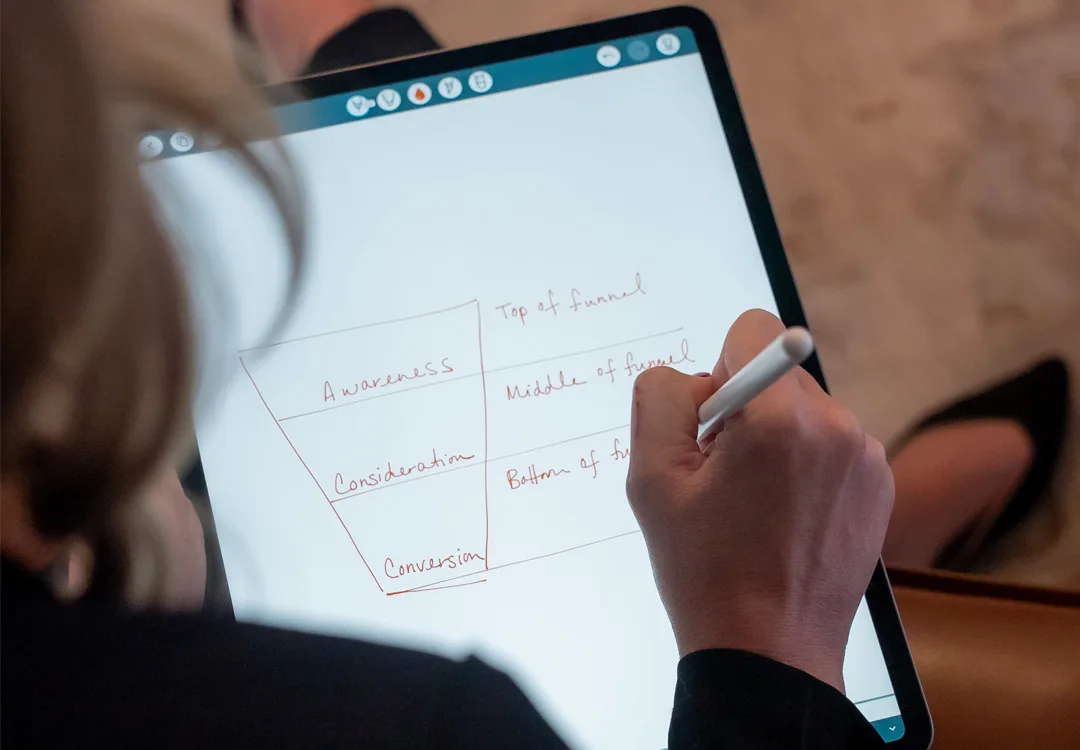
In today’s rapidly evolving digital landscape, staying ahead of marketing trends and techniques is crucial for any business aiming to thrive. As we step into 2024, refreshing your marketing strategy and adopting a full-funnel approach has never been more essential. This comprehensive guide offers you actionable insights to rejuvenate your marketing efforts and ensure your strategies are holistic, effective, and fully integrated.
Let’s start by understanding the difference between a marketing strategy and a marketing plan, concepts we often discuss at OTM. A marketing strategy defines “who” you are targeting and “why” they should choose you. A marketing plan details “what” actions you will take and “when” to execute them based on your strategy.
Simply put, your strategy sets the direction, and your plan outlines the steps to achieve it. Together, they ensure your marketing efforts lead to success.
Here are 4 steps from The OTM Path to Growth® that every business should take to refresh its strategy for the new year:
Step 1: Analyze the Market
Market analysis involves collecting, examining, and making sense of data to gain insights into a specific market or sector. Through an effective market analysis, businesses can uncover growth opportunities, predict and plan for future obstacles, and strategically position themselves for growth.
At OTM, a market analysis typically includes:
- Estimating the Target Addressable Market (TAM) to find ways to increase the market’s overall size.
- Grasping the target audience’s needs, preferences, and challenges to customize products or services more effectively.
- Keeping an eye on industry movements and shifts in consumer behaviors that could influence the market.
A thorough market analysis is key to spotting unmet needs in the market and developing strategies to either take advantage of these openings or navigate around potential pitfalls.
Step 2: Analyze Your Competition
After completing your market analysis, you should have a clear understanding of your target audience and who (or what) you are competing against for market share.
We recommend analyzing both direct and indirect competitors by creating comprehensive profiles for each. These should encompass details on their market share, financial status, size, customer demographics, product or service offerings, pricing strategies, distinct selling points, and promotional approaches.
Then, identify potential areas where your business can distinguish itself and pinpoint areas of improvement for your own business.
Check out our step-by-step guide: ‘How to Conduct a Competitive Analysis.’

Step 3: Audit Your Brand’s Story
Now that you understand the market and you know what sets you apart from your competition, it’s time to review your brand’s story.
At OTM, we utilize the 7-part StoryBrand framework developed by Donald Miller’s “Building a StoryBrand: Clarify Your Message So Customers Will Listen.”
The 7 parts of a StoryBrand consist of:
- A character (your customer) who has a specific want or need
- The problem (that you can solve) that is standing in their way
- A guide (your business) that can ultimately help them solve their problem
- With a plan that helps them go from where they are now to where they need to go
- A call to action
- That helps them achieve success
- And avoid failure
If crafting a compelling brand story seems daunting, consider exploring our resource, ‘A Brand Story Exercise: OTM’s Approach to Building a StoryBrand’.
As you refresh your marketing strategy, making sure you’re addressing the correct audience, tackling significant problems, and offering competitive value propositions that align with customer goals is key.
Step 4: Adjust Your Marketing Plan
With a refreshed understanding of your market, competition, and brand story, it’s time to realign your marketing plan. This involves setting new objectives and ensuring your tactics—be they digital campaigns, content marketing, or social media engagement—are primed to deliver on your strategy’s promise.

Step 5: Incorporating a Full-Funnel Marketing Strategy
One of the biggest mistakes we see business owners make when it comes to marketing?
Focusing on only one stage of the marketing funnel.
Adopting a full-funnel marketing strategy ensures that you address customer needs at every stage of their journey. Start by breaking down your strategy into three key stages: awareness, consideration, and conversion.
- Awareness: This is where the funnel is largest and you reach the most people, even those who are not yet seeking your product or services. Create informative and engaging content that addresses the problems and needs of your potential customers. Utilize SEO, social media, and content marketing to increase your visibility.
- Consideration: Here, the funnel begins to narrow, there are less people in this stage and they are beginning to consider your product or service, comparing it to others. At this stage, it’s great to offer more detailed and solution-oriented content, such as case studies, webinars, and product demonstrations, to help your audience evaluate your offerings.
- Conversion: This is when your audience is ready to make a purchase decision, it’s intent-driven and somewhat transactional. Implement targeted campaigns, such as email marketing and retargeting ads, to convert prospects into customers. Focus on providing clear value propositions and strong calls to action (CTAs in this stage to guide your audience to make a purchase or contact you).
But the funnel doesn’t end there.
Following conversion is nurture and what we at OTM like to call loyalty or engagement. This is where you work to retain, re-engage, upsell or cross-sell your existing customers (pro tip: it costs far less to keep a customer or client than it does to land a new one!)
A Cohesive Strategy for 2024
As you embark on refreshing your marketing strategy for 2024, remember that the integration of a full-funnel approach is crucial. By understanding your market, refining your brand’s story, realigning your marketing tactics, and embracing the entirety of the customer journey, you’re not just prepared to meet your audience where they are—you’re ready to guide them where they need to go.
Lead with strategy, manage with a plan, and let your marketing funnel be the bridge that connects your business’s aspirations with your audience’s needs.
Download our Persona Template now to kickstart your audience analysis and get your Full-Funnel Outline Template to meticulously plan your marketing activities across every stage of the customer journey.
Unlock the full potential of your marketing strategy now! Our Persona Template and Funnel Outline tools are designed to help you better understand your audience and effectively guide them through every stage of their journey.
